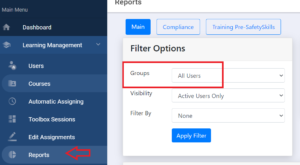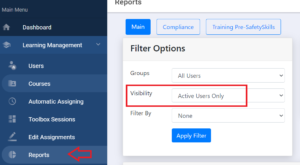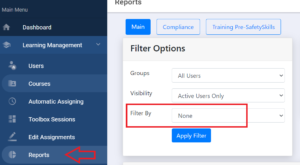If you have access to the “Reports” page of the system you are able to create, run and view reports to see how your learners are doing with their training. Some administrators can only run reports for the groups they have been given access to, while others will see all the users in the system.
Before you can create a report, you’ll want to determine the information you need. For example, do you want to see all completed training for a specific location? What about any overdue training for the last quarter for all departments, sorted by supervisor? Or what about a report for all completed training from the last year, including any employees who may have left the company? Once you know what information you need, you’ll be better equipped to navigate the myriad of filtering options available to you.
For this walk-through, we will be running a report for all users who have completed training during the first quarter of 2021, but only the training that was due for that quarter.
To begin, please click on “Reports” in the menu. On the left side, under “Filter Options,” are the main filters for running reports.
The first filter is where all created groups, if any, will appear.
For our example, however, we will assume I do not have any groups and will leave it at “All Users.”

The second filter, Visibility, determines the users who will display in the report based on their status. This filter gives you three options: Active Users Only, Deactivated Users Only, or Active and Deactivated Users.
In our example, I want to see all of the training that was scheduled to be due in quarter one of 2021, even for employees who may have left the company. In that case, we will select “Active and Deactivated Users.”

The next drop down is the date you would like to filter your report by. You are given four options:
- Activation Date would pull in courses that were activated, or available to be taken, during the date range
- Assigned Date would pull in courses that were assigned during the date range, but not necessarily available to be taken
- Completed Date would pull in any courses that were completed during the date range, even if they were completed after they were due
- Due Date would pull in courses that were due during the date range you select
For our example, we will select “Due Date,” as we are most interested in courses that were due to be completed during a specific time frame. We are not selecting completed date because that would only pull in courses that were completed, including any courses that may have been overdue from last year, or ones that are activated and not due until a future date. Selecting “Due Date” allows us to look at only those courses that are due during the date range we will select.

For the final filter, you will select the date range you would like the report to look at. You have multiple choices:
- Custom allows you to select a custom date range from a calendar
- In the Past will look at any information for today and prior to the day you are running the report
- Previous Month will look at any information in the month prior to the one you are running the report
- Current Month will look at any information in the same month as the one you are running the report
- Next Month will look at any information in the month after the one you are running the report
- In the Future will look at any information after the day you are running the report
For our example, we will be utilizing a Custom date range from January 1, 2021 to March 31, 2021, as we want to see all training that was due for this date range.

Currently, we have told the system to look at all courses that were due between January 1, 2021 to March 31, 2021 for all active and deactivated users within the account.
Once you have determined your filter settings, click “Apply Filter” to run the report. This will then pull in any information that fits the filters you have selected into the information grid below.
This is going to display a lot of information: it’s all training that was due, not necessarily all that was completed. This means we’ll have some training that is completed, some that is incomplete, and some that has not yet been attempted, for all learners in the system. However, this information is currently not sorted or grouped in any specific order.
There are a few different ways to organize this information. For our example, let’s assume we need to group by location and then by supervisor, so that I can distribute my report to the appropriate person in my company. Begin by clicking the “Add/Remove Columns” button in the upper left of the information grid. This is going to open a menu that allows you to remove or add new columns into the grid. These columns include your custom fields, as well as other necessary information, like Assigned Date.
Finally, I know I need to group all of the course information by location and manager. To do that, I will drag and drop first the “Location” column above the current column listing. This will group all of the report information by location first. Then, I’ll drag the “Manager” and “Login” columns up, to have the report group first by location, then by supervisor, and finally by login.
With the report currently grouped by Location, Manager, and Login, it will compress the report information. You may click on the “+” button to the left of each row to expand each selection. Each line is also summarized in the row displaying the total minutes, total assignments, total completions, the number completed on time, the completion percent and the on time percent.
Now, I can export my report to Excel by clicking one of the two export options at the upper right of the information grid.

You may also save this report to make it easier to access in the future. To do so, please review the sections about saving a report located in this article: How To Create and Run Reports
